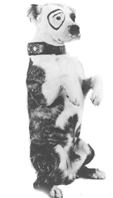GoodboysBaddogs
Member
 Posts: 47
From:Los Angeles, Ca.
Registered: Aug 2003
|
 posted 08-21-2003 01:29 AM
posted 08-21-2003 01:29 AM
  
Hello ALL Pit & BULL breed Lovers!?!
I'm just curious... What do you feed you dog(s)? Also, please mention what kind of dog, age, and if you excercise (or possibly work) your dog(s).-What kind of excercise & or work.
I personally own an American Bulldog "bully-type/Johnson" & a Chinese Shar Pei.
In advance, i'd just like to say "THANKS TO ALL THAT REPLY"....
-just another dog fanatic-------------------
...it's the understanding of what's wrong, when you only know how to do right... IP: Logged |
chris averitte
New Member
 Posts: 2
From:louisville, ky40216
Registered: Aug 2003
|
 posted 08-25-2003 08:36 PM
posted 08-25-2003 08:36 PM
  
I have a 3yr old female and a 1yr old male and they both like dog chow. The 3yr old is a colby/carver brindle and my male is mason hog/elie. I tried that stuff called nitro they [EDIT by moderator]***** bad for a month and then started pukin all the time.Then I tried the stuff that the vets have in their shops with the weird name,that messed tup their stomachs to.They have been happy with the dog chow[**NOTE TO POSTER: Edited Post. Please refrain from using inappropriate language in this forum. Thank you, Moderator] [This message has been edited by Jas (edited 09-05-2003).] IP: Logged |
PassionforPitbulls
New Member
 Posts: 8
From:West Warwick, RI USA
Registered: Sep 2003
|
 posted 09-02-2003 09:19 PM
posted 09-02-2003 09:19 PM
  
Hello:
Here is a great lesson in learning about dog foods. It helped me to pick out the best dog food for my dogs. I currently use Purina Pro Plan. I also give my dogs beef,liver, rice, veggies and bone marrow bones. Enjoy PS you might also want to visit this web site
http://www.api4animals.org/doc.asp?ID=79 In today’s competitive market, there are over 1000 brand names of dog foods, and equally as many boast that ‘theirs’ is the best. So how does the novice decide which food to feed and why?
Bag Labels:
Let’s begin by learning how to analyze what is in the bag. Labels tell the story. On all dog food labels we find panels of identification.
These panels cover the following information:
Company brand name and Logo (i.e.: Iams, Pedigree, Diamond, etc.)
Ingredient identifier. Such as, lamb and rice, chicken, chicken and rice, beef and so on.
Size and age identifier is also on this panel. This includes the size dog the food is appropriate for, and the age range. An example would be large breed puppy. And finally is the weight of the product in the bag. This information is noteworthy, but not where a seasoned dog expert looks to analyze dog food.
[]
The information guide shows us: 1. General analysis (shows the percentages of the food stuffs that makes up that particular brand).
2. Ingredients list (shows ingredients in descending order, by weight).
3. Nutritional adequacy claim (identifies life stage for which food is intended and whether animal feeding tests procedures were used).
4. Feeding instructions (how much of the food to feed your dog and how many times per day is recommended). The Guaranteed Analysis on the dog food label lists the minimum levels of crude protein and fat. It also shows the maximum levels of fiber and water. "Crude" refers to the total protein content, not the amount of protein that is actually digestible. What this means is that this is ONLY a crude protein percentage, and fat amounts are rough guides.
The amount of moisture in a food is important, especially when you are comparing foods. A food containing 24% protein and 10% moisture would have the same protein per serving as a food with 24% protein listed on the label but only 6% moisture. The thing to consider here is that you are buying water instead of food.
Ingredient Listing:
Ingredients are listed in descending order, by weight. However, the listings may be misleading. Suppose chicken is listed as the first ingredient. This would cause you to think it is the primary ingredient. This may not be the case. If it's followed by wheat flour, wheat germ, wheat middling and so on, the combined wheat products may very well total much more than the chicken.
Preservatives:
BHA and BHT are chemicals that have been used to preserve dog food. They are associated with liver damage, abnormalities in puppies, and have been linked to cancer.
Ethoxyquin is one of the most heard of and discussed preservatives. Links to cancer, thyroid abnormalities, and liver and kidney failure have been debated about this product. Propylene Glycol was actually designed for use in wax and antifreeze. It is associated with hair loss, skin problems, diarrhea and even death in dogs and cats.Sodium Nitrate is used as a food coloring as well as preservative. It has been shown to cause cancer. Tocopherals are considered the good news in preservatives for dog foods. They are a naturally occurring preservative, which function as antioxidants. The only downside to using tocopherals is their relatively short shelf life. Protein and Age:What is acceptable for a puppy concerning protein content is in no way appropriate for an aging dog. Many dog foods on the market carry a protein range of 23% to 29% and sometimes even higher. For a puppy or young dog that is active much of the day, this is an acceptable rate. However, for an aging dog, this amount of protein, particularly the 26 – 29% range can cause many problems; kidney failure, acidity in the urine, and obesity to name a few. It is wise to determine your dog’s activity le |




 Auspet - Message Boards
Auspet - Message Boards

 - Dogs - Pit bulls
- Dogs - Pit bulls

 WHAT DO YOU FEED YOUR PITTY?!?
WHAT DO YOU FEED YOUR PITTY?!?











